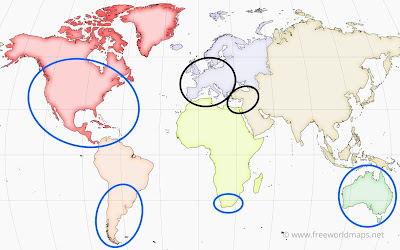These general statements obviously influence what end ups in the bottle. All making significant differences with the key notes, structure, new oak usage, and labelling.
Old World (Europe)
Lighter Body
Lower Alcohol
Higher Acid
Earth, Mineral, Herb, Floral Driven
Terroir Made
Regional Labelling (ex. Chianti)
New World (Everywhere Else)
Fuller Body
Higher Alcohol
Lower Acid
Fruit Driven
Higher New Oak Usage
Higher Extracted
Winemaker Made
Variety Labelling (ex. Cabernet Sauvignon)
Remember there are always exceptions to the rule. For example, the Niagara Peninsula in Ontario is a significantly cooler growing region than Napa Valley in California, and therefore can be considered more old world in style. However, it's a great place to start when picking out a bottle at a Bottle Shop/LCBO or pairing it with food.
*Image from freeworldmaps.net*

Comments
Post a Comment